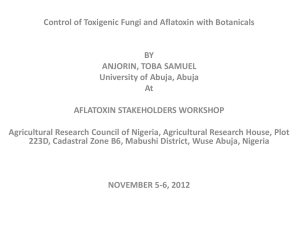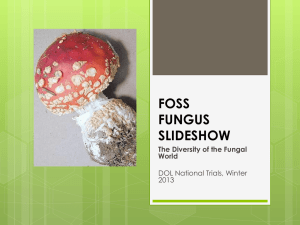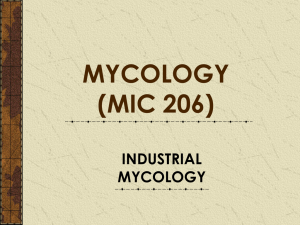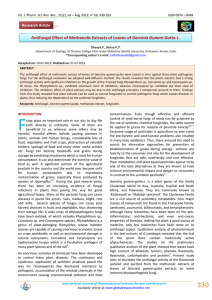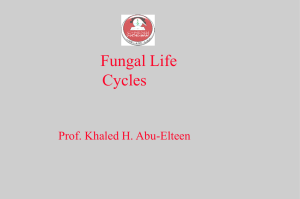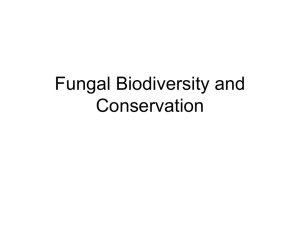Chemical Control of Fungal Decay in Buildings
advertisement
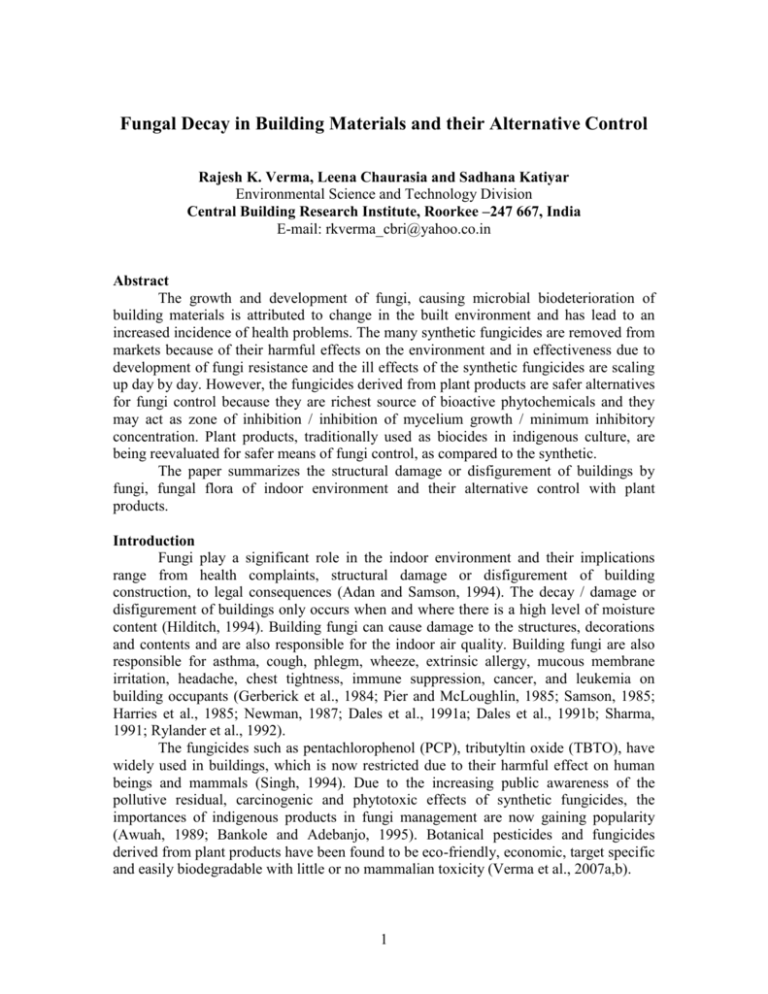
Fungal Decay in Building Materials and their Alternative Control Rajesh K. Verma, Leena Chaurasia and Sadhana Katiyar Environmental Science and Technology Division Central Building Research Institute, Roorkee –247 667, India E-mail: rkverma_cbri@yahoo.co.in Abstract The growth and development of fungi, causing microbial biodeterioration of building materials is attributed to change in the built environment and has lead to an increased incidence of health problems. The many synthetic fungicides are removed from markets because of their harmful effects on the environment and in effectiveness due to development of fungi resistance and the ill effects of the synthetic fungicides are scaling up day by day. However, the fungicides derived from plant products are safer alternatives for fungi control because they are richest source of bioactive phytochemicals and they may act as zone of inhibition / inhibition of mycelium growth / minimum inhibitory concentration. Plant products, traditionally used as biocides in indigenous culture, are being reevaluated for safer means of fungi control, as compared to the synthetic. The paper summarizes the structural damage or disfigurement of buildings by fungi, fungal flora of indoor environment and their alternative control with plant products. Introduction Fungi play a significant role in the indoor environment and their implications range from health complaints, structural damage or disfigurement of building construction, to legal consequences (Adan and Samson, 1994). The decay / damage or disfigurement of buildings only occurs when and where there is a high level of moisture content (Hilditch, 1994). Building fungi can cause damage to the structures, decorations and contents and are also responsible for the indoor air quality. Building fungi are also responsible for asthma, cough, phlegm, wheeze, extrinsic allergy, mucous membrane irritation, headache, chest tightness, immune suppression, cancer, and leukemia on building occupants (Gerberick et al., 1984; Pier and McLoughlin, 1985; Samson, 1985; Harries et al., 1985; Newman, 1987; Dales et al., 1991a; Dales et al., 1991b; Sharma, 1991; Rylander et al., 1992). The fungicides such as pentachlorophenol (PCP), tributyltin oxide (TBTO), have widely used in buildings, which is now restricted due to their harmful effect on human beings and mammals (Singh, 1994). Due to the increasing public awareness of the pollutive residual, carcinogenic and phytotoxic effects of synthetic fungicides, the importances of indigenous products in fungi management are now gaining popularity (Awuah, 1989; Bankole and Adebanjo, 1995). Botanical pesticides and fungicides derived from plant products have been found to be eco-friendly, economic, target specific and easily biodegradable with little or no mammalian toxicity (Verma et al., 2007a,b). 1 Damage or disfigurement in buildings by fungi Every living being on earth is harmed or benefited directly or indirectly by fungi. They can attack building timbers, stored goods, clothing, animals and even their own bodies, through allergy and diseases. They also attack objects, specimens, books and paintings in controlled environment (Verma et al., 2007b). The built environment of buildings provides ecological niches for the development of fungi, according to a number of factors, including design and construction, shape configuration, materials and structures. The main environmental parameters favouring the decay of building materials and contents are water, humidity, increased temperature and the lack of ventilation (Singh, 1994). Fungal flora of indoor environment The fungal flora of indoor environment is generally represented by common species of the genera Penicillium, Aspergillus and Cladosporium (Beaumont, 1985; Fradkin et al., 1987; Hunter et al., 1988). These genera can play a significant role in allergies and other health complaints (Gravesen, 1978; Beaumont, 1985; Samson, 1985; Hunter et al., 1988; Miller et al., 1988). In both damp and relatively dry living and working environment, xerophilic species of the genera Eurotium, Aspergillus and Wallemia are regularly found and there are indications that these molds also may be involved in health problems. The fungal flora on surfaces may differ depending on relative humidity levels. In wet rooms such as bathrooms or kitchens, the fungal flora often consists of darkly pigmented hyphomycetes or yeast. Common species occurring in such rooms on tiles, plaster or silicon caulking, are Aureobasidium pullulans and Phoma exigua, but also Alternaria alternata, Aspergillus niger, Cladosporium herbarum, C. sphaeropermum, C. tenuissimum, Ulocladium spp. and yeast can be found. Tiefenbruuner (1990) reported Penicillium, Fusarium, Trichoderma, Phoma and Cladosporium as common genera in wet rooms. Wallpaper may serve as good substrate for various species: Acermonium strictum, Aspergillus nige,r A. versicolor, Cladosporium herbrum, C. sphaerospermum, Epicoccum nigrum, Fusarium solani, Gymnoascus spp, Penicillium aurantiogriseum, P. glabrum, P. citrinum, P. chrysogenum, P. coryophium, Stachybotrys chartarum, Ulocladium spp., and yeast species (Singh, 1994). Chemical control of fungi in buildings There are two steps in eliminating fungal decay in buildings. The first step is to find out the reason of dampness / moisture in buildings. Building can take a long time to dry out, particularly if wall are very thick. Re-growth of surviving fungi is a risk during this period, if damp-proofing measure are ineffective, or if there is subsequent entry of damp by another route. The second step of fungi elimination is to remove decayed and infected timber, etc. followed by chemical treatment with suitable fungicides (Hilditch, 1994). The purpose of chemical treatment is to sterilize and protect sound timber that is to be left in place, and to sterilize infected walls, grounds, etc. Chemical treatment is carried out within a building for following reasons: (i) to eradicate any fungi that has only just started to grow into timber that does not yet appear decayed, (ii) to kill any mycelium missed in cleaning up, (iii) to sterilize surfaces 2 contaminated with spores, (iv) to contain mycelium in walls and (v) to provide a level of protection against infection and attack. Active Ingredients Conventionally used fungicides may be classified in two groups: Organic solvent based and water borne. For both organic solvent and water borne preservers the active chemicals are dissolved in a carrier liquid. Organic solvent based preservatives have been the backbone of the remedial treatment industry, for both decay and insects, since its inception; this is result from the advantages of ready penetration, absence of swelling, or distortion, rapid drying (relative to water) and cleanliness, giving efficacy greater than any other preservative type when applied by methods available for use in treatment of timber in place in a structure. Water based preservative penetrates particularly slowly than organic solvent based preservative. Water borne preservatives are only applied by high-pressure method. There are few active ingredients, which has been used for treatment of decay in buildings. Pentachlorophenol (PCP) It was a broad spectrum and economical fungicide and became the most common active compound for organic solvent-based preservatives through out the world. PCP has a slight volatility, which results in some loss from the immediate surface. It may be detectable in the air in treated locations. It was widely used for in situ treatment of wet or dry rot but under the Control of Pesticides Regulations (CPR) applications in buildings is now restricted. Tributyltin oxide Tributyltin oxide (TBTO) was used for both pretreatment and remedial treatment of timber extensively. It was a highly effective fungicide particularly easy to formulated and over-paint. Animal studies on TBTO gave concern about a potential immunotoxic and teratogenic effect so that it was restricted. Now a days acypetacs –zinc (3% Zn) and zinc salts of high molecular weight organic acids (naphthenate, octoate, versatate), organoboron ester (tri-hexylene glycol biborate), IPBC (3- iodo- 2- propenyl – n- butyl carbamate), TCMTB (2(thiocyanomethylthio) benzothiazole) and azaconazole have using to control fungal decay in buildings. Work done at CBRI A systematic research work was started in this Institute during the last 10 years to survey, extract and screen the leaves, bark, flowers, peels and roots of medicinal plants for their antifungal activity against building fungi. A number of plants and trees from nearby locations have been studied. A few of them exhibited encouraging antifungal activity (Chaurasia and Verma 2004; Verma et al., 2007a,b). The 1750 gm bulb of Allium sativum (Alliaceae) has purchased from local market. The cloves of A. sativum were peeled followed by cutting in to small pieces. The small pieces of cloves was deoiled with petroleum ether and extracted with water, methyl alcohol and methyl alcohol: water (90:10) followed by concentration on Rotary Vacuum Evaporator to get their crude extracts. The obtained three extracts were fractionated according to nature of compounds with hexane, chloroform and partition between nbutanol –water. All the obtained extract was screened for their antifungal activity against Aspergillus niger by adopting food poising method (Grover and Moore, 1962; Pandey et 3 al., 1982; Verma and Chaurasia, 2005) at 50, 100, 200, 300, 400 and 500 ppm. The pure solvent was used for control study. The experiment was performed in triplicate. Table 1. Diameter (mm) of fungal colony of Aspergillus niger growing on PDA after 72 hrs. Extracts 50 100 200 300 400 500 ppm ppm ppm ppm ppm ppm Petroleum ether * 10 1.1 7.6 1.7 extract Methanol extract * 8 1.3 5.3 1.1 Methanol: Water * 8.6 0.5 7 0.73 8.3 0.7 4 0.7 (Ratio) extract Methanol: * 12.5 2.4 9.3 0.7 5.6 0.9 5 0.4 Chloroform extract Ratio: Chloroform 13.6 1.5 6.3 0.7 * extract Water: Chloroform * 5 0.4 extract Methanol: Butanol * extract Ratio: Butanol * extract Water: Butanol * 12 0.9 6.3 0.92 6.0 0.7 extract Methanol: Water 15.6 1.9 11 1.6 9.6 1.2 8 1.2 6 0.9 3.3 0.7 extract *MIC = Minimum Inhibition Concentration The colony diameters of Aspergillus niger growing on potato dextrose agar exposed with various extracts / components isolated from bulb of Allium sativum with different solvents after 72 hours of incubations at 280C has been presented in Table –1. All extracts exhibited fungitoxicity as compared to control. The Methanol: Butanol and Ratio: Butanol extracts exhibiting the highest antifungal potency (MIC) at 50 ppm of concentration after 72 hours of incubation (280C) against A. niger. However, Water: Chloroform extract exhibited moderate fungi toxic potency (MIC) at 100 ppm and other extracts exhibited least antifungal potency. The MIC of these extracts was observed at 200-400 ppm. The fungitoxicity may be due to the presence of allicin, diallyl disulfide, diallyl trisulfide, allin and s-methyl- L- cysteine sulfoxids and other chemical compounds in tested extracts of Allium sativum. Further work has been in progress to determine the actual active ingredients. Conclusion Building fungi affects the health of occupants. Symptoms include fatigue, headaches, skin irritation and mucous membrane trouble. The PCP, TBTO, Zinc carboxylate and boron esters has widely used for treatments of fungal decay in buildings has been now restricted for their use due to their toxicity against mammals and human beings. It is also apparent that few extracts of A. sativum have promising antifungal potency against building fungi. A proper study of these plant extracts and structure 4 relationship will bring about a new class of interesting compounds for future fungi control. Acknowledgement Authors are grateful to Dr. M. O. Garg, Director, CBRI, for his constant encouragement and this paper is presented with his kind permission. References Adan O C G and Samson R A, Fungal disfigurement of interior finishes, in Building mycology (eds Singh J), Chapman and Hall, London, UK, 1994. Awuah RT, Fungitoxic effect of extract from some West African plants, Annals App. Biol. 115, 451-453, 1989. Bankole S A, and Adebanjo A, Inhibition of growth of some plant pathologens by plant extracts from some Nigerian medicinal plants, Intern. J. Trop. Plant Dis. 13, 91-95, 1995. Beaumont F, Aerobiological and clinical studies in mold allergy, University of Groningen, PhD thesis, 1985. Chaurasia L and Verma R K, Occurrence of vegetative growth in buildings of tropical region: analysis and control (Ushan katibhandiya bhawano mein pie janae wali vanaspatic vardhia: veslasion evam upchar), Manthan (Hindi) 2: 32-38, 2004. Dales R E, Burnett R and Zwanenburg H, Adverse health effects among adults exposed to home dampness and molds, Am. Rev. Resp. Dis. 143: 505-509 1991a. Dales R E, Zwanenburg H, Burnett R and Frankin C A, Respiratory health effects of home dampness and molds among Canadian children, Am. J. Epidem. 134: 196-203, 1991b. Fradkin A, Tobin R S, Tarlo SM, Tuucic-Porrtta M and Malloch D, species Identification of airborne moulds and its significance for the detection of indoor pollution, JAPCA 37: 51-53,1987. Gerberick G F, Sorenson W G, and Lewis D M, The effects of T-2 toxin on alveolar macrophage function in vitro, Envir. Res. 33: 246-260, 1984. Gravesen S, Identification and prevalence of culturable mesophilic fungi in house dust from 100 Danish homes, Allergy 33: 268, 1978. Grover, R K and Moore, J D, Toximetric studies of fungicides against brown rot organism, Sclerotinia fructicola and S. laxa. Phytopathol. 52: 876-880, 1962. Hilditch E A, Chemical control of fungal decay in buildings, in Building mycology (eds Singh J) Chapman and Hall, London, UK, 1994. Hunter C A, Grant C, flannigan B and Bravery A F, Mold in buildings: the air spore of domestic dwellings, Intern. Biodet. 24: 81-101, 1988. Harries M G, Lacey J, Tee R D, Cayley G R and Newman Taylor A J, Didymella exitialis and late summer asthma, Lancet 1063-1066,1985. Miller J D, Lafalmme AM, Sobol Y, Lafontaine P and Greenhalgh R, Fungi and fungal product in some Canadian house, Intern. Biodet. 24: 103-120, 1988. Newman Taylor A J, The lung and the work environment, in Current perspectives in the immunology of respiratory disease, Edition by A B Kay, E. J. Goetzl., Churchill Livingstone, Edinburgh, pp. 55-67, 1987. Pandey, D K, Chandra, H and Tripathi, N N, Volatile fungi toxic activity in higher plants with special reference to that of Callistemon lanceolatus DC, Phytopathol. 105: 175-182, 1982. 5 Pier A C and McLoughlin M E, Mycotoxic suppression of immunity, in Trichothecenes and Other Mycotoxins, Edition by J Lacey, John Wiley, Chichester, pp. 507-19, 1985. Rylander R, Persson K, Goto H et al, Airborne β-1, 3- glucan may be related to symptoms in sick buildings, Indoor Environ. 1: 263-267, 1992. Sharma R P, Immunotoxic effect of mycotoxins, in Mycotoxins and phytoalexins, Edition by RP Sharma and DK Salunkhe, CRC press, Boca Raton FL, pp.81-99, 1991. Samson R A, Occurrence of moulds in modern living and working environments, Eur. J. Epid. 1: 54-61 1985. Singh J, Building Mycology, 1st Edition by Chapman and Hall, London, UK, 1994. Tiefenbrunner, F, Pilze in Nassraeumen, in Schimmelbefall in Wohnbauten:Ursachfolgen- Gegenmaβnahmen (eds Waubke, N. E. and Kusterle, W.), 1. Internationales Symposium, Innsubruck, pp. 109-115 (in German), 1990. Verma, R K and Chaurasia, L Synthesis and antifungal studies of some novel pyrazolopyridine derivatives, J. Indian Chem. Soc. 82: 665-669, 2005. Verma R K, Chaurasia L and Katiyar S, Evaluation of antifungal potency of Citrus essential oils against building fungi, Pestology 31(1): 29-31, 2007a. Verma R K, Chaurasia L and Katiyar S, A review on building fungi and medicinal plants exhibiting antifungal activity, Nat. Prod. Rad. (In press), 2007b. 6

